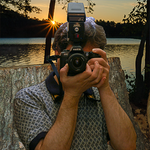- Home
- Photoshop ecosystem
- Discussions
- Removing newsprint pattern from photos.
- Removing newsprint pattern from photos.
Copy link to clipboard
Copied
Have some old photos, some with newsprint patterns. ?Any way to remove the ink-dot pattern?
 1 Correct answer
1 Correct answer
HI R Lede,
Please follow the below steps that might help you:
1. The first thing you want to do is scan the newspaper in at a very high resolution.(600dpi). Sometimes you will want to scan the image at an angle to help avoid as much of a moire pattern as possible.
2. In Photoshop, duplicate the layer and make it a Smart Object – not necessary to do both.
3. Add a Gaussian Blur of 3.7 pixels to essentially merge the dots and create smoother gradients. This amount may vary depending on the s
...Explore related tutorials & articles
Copy link to clipboard
Copied
HI R Lede,
Please follow the below steps that might help you:
1. The first thing you want to do is scan the newspaper in at a very high resolution.(600dpi). Sometimes you will want to scan the image at an angle to help avoid as much of a moire pattern as possible.
2. In Photoshop, duplicate the layer and make it a Smart Object – not necessary to do both.
3. Add a Gaussian Blur of 3.7 pixels to essentially merge the dots and create smoother gradients. This amount may vary depending on the size of the dots and the resolution at which you scanned.
4. Then apply the Unsharp Mask filter with settings:
- o Amount: 120%
- o Radius: 5px
- o Threshold: 1 level
Applying too much sharpening will introduce halos around the edges which will take away from the impact of the image and will look very unprofessional.
5. Resample the image to your end resolution. The resampling will help remove some of the apparent blurriness of the image as well.
6. At the end, just add a simple Curves Adjustment Layer to add some contrast.
Regards
Sarika
Copy link to clipboard
Copied
Than kyou indeed! Have a nice day from a small hill town in central Italy!
Copy link to clipboard
Copied
Some scanning programs (like Epson Scan) have a Descreen option, which is designed to remove these patterns.
But the way I understand your post, these are photos (prints?) of newspapers, so I'm not sure how well it would work.
The best thing would obviously be to scan the newspaper itself, if you have access to it.
Copy link to clipboard
Copied
Good morning,
I appreciate your suggestions and thank you for your attention,
raul
Copy link to clipboard
Copied
Good morning Sarika.
In first place I thank you for your guidance.
Next after trying your suggestions, I tweaked your parameters to find the best settings and voila!
The newsprint dot pattern was gone.
Thank you again and have a best day,
raul
Copy link to clipboard
Copied
Good morning Sarika.
In first place I thank you for your guidance.
Next after trying your suggestions, I tweaked your parameters to find the best settings and voila!
The newsprint dot pattern was gone.
Thank you again and have a best day,
raul
Copy link to clipboard
Copied
You could also try this plugin:
Copy link to clipboard
Copied
Hi, Thanks for the link; I’ll look it up.
Copy link to clipboard
Copied
Worked like a charm!!
I've been scanning, editing and inserting old newspaper sourced photos into a book I'm writing and this fix was simple and effective. Thank you.
Now to get correct the yellowing of the newspaper background...
Copy link to clipboard
Copied
@scurvey dog: Use Photoshop Camera Raw's White Balance adjustment, the little eyedropper on the left.
Copy link to clipboard
Copied
You can also looking into using a FFT filter. It's good for removing textures from images.
Copy link to clipboard
Copied
Chuck Uebele wrote:
You can also looking into using a FFT filter. It's good for removing textures from images.
I can't believe it took seven replies for FFT to be suggested. ![]()
Copy link to clipboard
Copied
Me too.
Copy link to clipboard
Copied
Ok Chuck, you can believe it, I have no idea what an FFT filter is, but I am willing to learn though.
I always hated acronyms . . . But now more than ever, they just serve to emphasise my ignorance spots and my slow motions which, at eighty three, are things of which I am fully aware already . . . But I thank you very kindly anyway. In the process I received a suggestion and guide for using the Gaussian blur and the Unsharp mask in PhotoShop which did and excellent job. Thanks again Sarika!
Copy link to clipboard
Copied
I'm glad I'm not the only one who has no idea what an FFT filter is. But I'm 80 so, Raul, maybe it's age related!
David
Copy link to clipboard
Copied
Never ! ! ! The only thing that I think relates to age, is a shortening of one’s patience regarding things which had never excited us before . . . I would give you an example, but I don’t remember it now . . . Oh well ! ! ! If we managed to get here, I am positive we can take whatever is thrown at us in what’s still left to go. Have a great day.
Copy link to clipboard
Copied
@R Lede and AnotherDavid
I want to thank you both for having no reluctance to state your age. If this were a perfect world, you would be due some extra respect (until proving you don't deserve it—which, for elders is a high bar) for having stuck around getting smarter for 83 and 80 years, respectively. In return for such basic respect, you can share what you've learned with people behind you on the curve, like myself, trucking along in my 78th year on the third planet from the sun. I, too, am looking for a solution to the moire pattern problem, using an older version of Photoshop Elements. I'll check out as soon as I'm done commenting and give these a try.
I, too, did not know what an FFT filter is, despite having taught myself Photoshop, how to write and sell novels, and most of the rest of what I've learned since Day 1, when I first breathed the sweet air of this Earth. I've used computers since the early eighties when I paid through the nose for an Apple II plus, 48K of extra ram, two 5.25 floppy drives, a C Itoh printer and Wordstar. All of this setup rests in its honored place under my basement steps. Despite the multitude of evils the internet has handed to lazy psychopaths, for those who always want to know more, it offers several quantum jumps in the ease of learning just about anything. This forum is an exemplary. . .erm. . .example. You young-uns' (if you're still reading) have been spared jumping in your '69 Nova, driving to the library, then hours spent poring through card catalogs only to find the single copy of the book on ancient Egypt you want has been checked out. I offer this as a way to feel lucky when your day has gone to hell.
I'm sure you two older guys both know the following, so I'll speak only for myself. One thing I've learned is that, however much I have learned, the universe of things I _don't_ know dwarfs by multiple magnitudes what I've been able to find out in the time given me to this point. That will be true if I make it to 100 like my father, or 101 like my mother in her determined effort to beat Dad's mark. Dad went first, parting from their marriage in its 78th year.
Finally, those who bailed early will miss my explanation for what, in this era of Twitter, must seem a long comment. First, I regard Twitter as the poison that has made brevity the _sl f ntwts_ . Second, I will come only this close to an apology for the length of this comment: Forty-plus years of writing novels would distort anyone's perspective on what constitutes a long comment or email.
Auf Wiedersehen from Spruill's basement.
Copy link to clipboard
Copied
FFT stands for fast fourier transformation. I have no idea what that means, but I do know that FFT filters can take out repeating patterns in images very well. It's take some practice and it's an odd plugin.
Copy link to clipboard
Copied
Thanks for that info. I just did a search for it (can still manage that), and downloaded the trial version. Now I'll have to scan some newsprint to try it out. The color deconvolution plug-in looks good too, especially for restoring old family photos, so I'll try that too.
David
Copy link to clipboard
Copied
Thanks for the light Chuck, if I still remember from school, it had some to do with diffraction.
Have a good day
Copy link to clipboard
Copied
Another tool to try is the Median filter. It can help to rotate your image first, so that the dots got vertical and horizontal, and resize the image so that the spacing between the dots is on even pixel boundaries (since the Median filter can't be set to fractional pixel values). Note the values you use for these operations, and when you're done, use complementary value to restore your image to its original size and orientation.
Copy link to clipboard
Copied
FYI, these are called 'halftone patterns'.
Find more inspiration, events, and resources on the new Adobe Community
Explore Now


